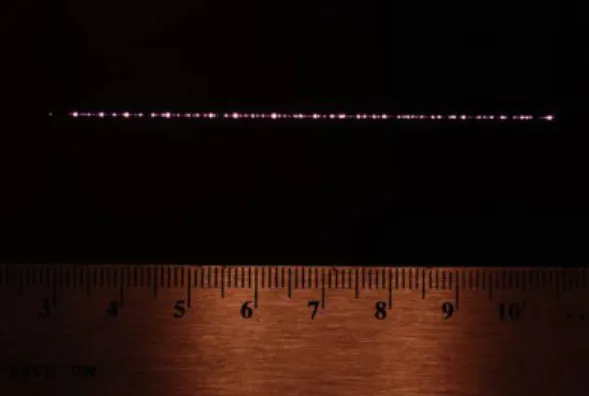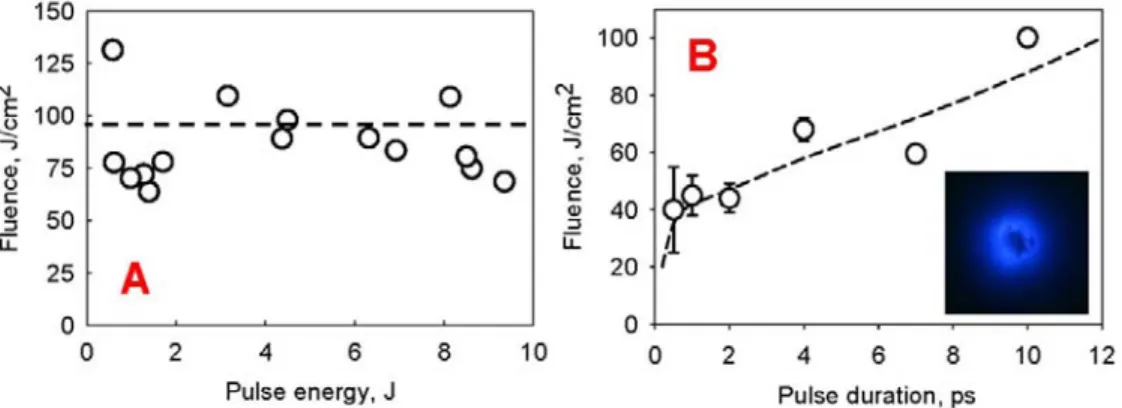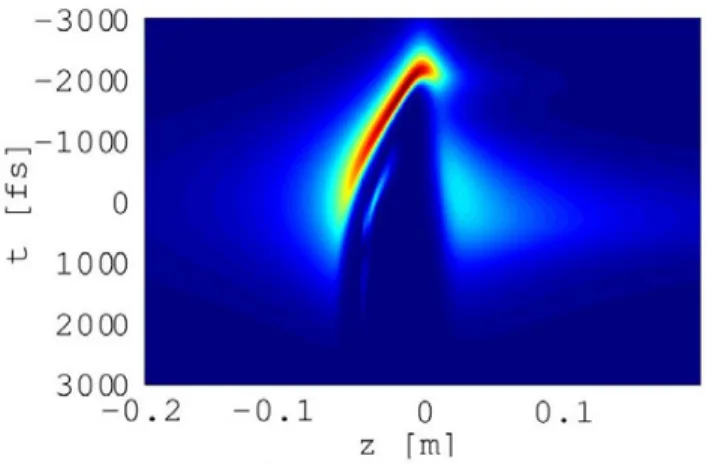HAL Id: hal-01182319
https://hal.archives-ouvertes.fr/hal-01182319
Submitted on 3 Aug 2015HAL is a multi-disciplinary open access archive for the deposit and dissemination of sci-entific research documents, whether they are pub-lished or not. The documents may come from teaching and research institutions in France or abroad, or from public or private research centers.
L’archive ouverte pluridisciplinaire HAL, est destinée au dépôt et à la diffusion de documents scientifiques de niveau recherche, publiés ou non, émanant des établissements d’enseignement et de recherche français ou étrangers, des laboratoires publics ou privés.
Picosecond Laser Filamentation in Air
Pavel Polynkin, Andreas Schmitt-Sody, Heiko Kurz, Luc Bergé, Stefan Skupin
To cite this version:
Pavel Polynkin, Andreas Schmitt-Sody, Heiko Kurz, Luc Bergé, Stefan Skupin. Picosec-ond Laser Filamentation in Air. Nonlinear Optics, Jul 2015, Kauai, Hawaii, United States. �10.1364/NLO.2015.NTh1A.6�. �hal-01182319�
Picosecond laser filamentation in air
Pavel Polynkin1,Andreas Schmitt‐Sody2, Heiko G. Kurz3, Luc Bergé4 and Stefan Skupin5
1. College of Optical Sciences, University of Arizona, Tucson, Arizona, USA 2. Air Force Research Laboratory, Albuquerque, New Mexico, USA 3. Institut für Quantenoptik, Leibniz Universität Hannover, Hannover, Germany
4. CEA, DAM, DIF, 91297, Arpajon, France
5. Univ. Bordeaux - CNRS - CEA, Centre Lasers Intenses et Application, UMR 5107,33405 Talence, France
Email : ppolynkin@optics.arizona.edu
Laser-generated plasmas in air have potential utility in diverse application areas ranging from the guidance of electrical discharges to remote sensing. Ionization of air and other gases by powerful laser pulses has been intensely investigated in the femtosecond [1,2] and nanosecond [3] regimes. However, plasma channels produced through fs excitation are dilute and short-lived, while plasmas generated through nanosecond optical breakdown are ty pically fragmented into disconnected plasma bubbles. Both shortcomings severely limit practical applicat ions. Attempts to combine femtosecond and nanosecond laser excitations in the so-called igniter-heater scheme [4] do result in the production of extended and dense plasma channels, but, like in the case of pure nanosecond excitation, the generated plasma channels are fragmented into discrete bubbles, as shown in Figure 1. The fragmentation effect is attributed to the periodic focusing of the nanosecond heater pulse by the rotational revivals impulsively initiated by the femtosecond igniter pulse.
Figure 1: Photograph of a plasma channel produced in air through the combined
femtosecond-nanosecond laser excitation (igniter-heater scheme). The channel is dense but fragmented into individual plasma bubbles.
In this contribution, we explore, both experimentally and n umerically, an under-investigated regime of air ionization by intense near-infrared laser pulses with duration in the picosecond range. Earlier experiments have shown that in this regime the generated plasma channels can be both dense and continuous [5]. Here we use weakly focused laser pulses at 1,053 nm wavelength, with pulse durations variable from 0.5 to 10 picoseconds, and with the laser-pulse energies of up to 10 Joules. Plasma channels generated in air by such pulses are approximately uniform, both longitudinally and transversely, as shown on the single-shot photograph of plasma luminescence in Figure 2.
By examining burn patterns produced on a glas s surface by the intense laser beam in the filamentation zone we show that the phenomenon of int ensity clamping that has been originally demonstrated for the case of femt osecond laser filaments [6], holds in the picosecond regime. The value of the fluence steadily grows as the pulse duration increases, as shown in Fig. 3(B).
Figure 2: Photograph of a plasma channel produced in air through filamentation of a 10
Joule picosecond laser pulse at 1053 nm wavelength. The channel is both dense and continuous.
Figure 3 A: Optical fluence inside the filament produced by a 10 picosecond-long laser
pulse, vs. input pulse energy. The fluence is ~100 J/cm2 for all pulse energies, a direct
consequence of intensity clamping inside the filament. B: Fluence vs. pulse duration. The inset shows the far-field fluence distribution. The shadow pattern is consistent with the screening of the laser beam by thick and dense plasma channel in the middle of the beam surrounded by several smaller plasma filaments.
Numerical simulations reveal t hat an intense, clamped spike develops on propagation, on the leading temporal edge of the pulse. Full ionization of both oxygen and nitrogen is reached, thus plasma densities attainable with energetic picosecond excitation are significantly higher than those in femtosecond laser filaments, which is a direct consequence of the longer pulse durations. Our results suggest that picosecond laser filamentation in air may have the advantages of both femtosecond and nanosecond plasma excitations, without the drawbacks associated with either of the two regimes.
This work was supported by the US Air Force Office of Scie ntific Research under programs FA9550-12-1-0143 and FA9550-12-1-0482 and by the US Defence Threat Red uction Agency under program HDTRA 1 -14-1-0009. The use o f the Jupiter Laser Facility was supported by the US Department of Energy, Lawrence Li vermore National Laboratory, under Contract No. DE-AC52-07NA27344.
Figure 4: Simulation of the on-axis temporal evolution of a 2 ps-long laser pulse
propagating through the filamentation zone, showing the development of an intense,
clamped spike (~80 TW/cm2) on the leading edge of the pulse.
References
1. A. Couairon, A. Mysyrowicz, “Femtosecond filamentation in transparent media”, Phys. Rep. 441, 47 (2007).
2. L. Bergé, S. Skupin, R. Nuter, J. Kasparian, J.-P. Wolf, “Ultrashort filaments of light in weakly ionized, optically transparent media”, Rep. Prog. Phys. 70, 1633 (2007).
3. Principles of laser plasmas, G. Bekefi ed. (Wiley, New York, 1976).
4. P. Polynkin, J. Moloney, “Optical breakdown triggered by femtosecond laser filaments”, Appl. Phys. Lett. 99, 151103 (2011).
5. D. Kartashov, S. Alisauskas, A. Baltuska, A. Schmitt-Sody, P. Roach, P. Polynkin, “Remotely pumped stimulated emission at 337 nm in atmospheric nitrogen”, Phys. Rev. A 88, 041805(R) (2013).
6. S. Xu, J. Bernhardt, M. Sharifi, W. Liu, S. L. Chin, “Intensity clamping during laser filamentation in air and argon”, Las. Phys. 22, 195 (2012).


